If you’ve ever agonized over an executive summary, you’re not alone. How do you condense your entire project into a single page—or worse, a single paragraph—and still make it stand out?
Whether it’s called an executive summary, a proposal abstract, or a summary statement, this section plays a critical role in your proposal. It’s often the first thing reviewers read, and sometimes the only thing they remember.
So how do you make sure your summary doesn’t just check a box, but actually grabs attention and pulls the reviewer in? Let’s break it down.
1️⃣ Know Its Job
An executive summary isn’t just a recap—it’s your pitch. It should give the funder a clear, compelling snapshot of your organization, the problem you’re addressing, what you’re going to do about it, and what difference it will make.
Think of it like a movie trailer: it doesn’t show every scene, but it gives you just enough to understand the plot and get excited to see more.
A strong summary should include:
✅ Who you are
✅ What problem you’re tackling
✅ What solution you’re proposing
✅ Who will benefit
✅ What kind of impact you expect to make
✅ (Optional but powerful) Why you’re the right organization to do this
2️⃣ Write It Last (Even If It Comes First)
This is one of the most common mistakes: trying to write the executive summary before the rest of the proposal is finished. Don’t do it.
Instead, wait until the full proposal is drafted. Then pull key sentences and phrases from each section and use them to build your summary. You’ll have more clarity, stronger language, and a better sense of what really needs to be included.
💡 Pro tip: Your executive summary doesn’t have to say everything—but it should make the reader want to keep reading.
3️⃣ Lead with What Matters Most
Your opening sentence needs to immediately communicate relevance. Don’t start with a generic description of your organization’s founding year or mission. Start with the problem you’re addressing or the big-picture outcome you’re working toward.
Compare these:
❌ “We are a 501(c)(3) nonprofit founded in 1996 to serve community needs.”
✅ “In our city, nearly 1 in 3 children under five live in food-insecure households. Our early nutrition program tackles this crisis head-on.”
Which one makes you want to learn more?
4️⃣ Avoid Jargon and Buzzwords
Executive summaries often go sideways when they’re written in “grant-speak”—overly complex, buzzword-heavy, and vague. Your summary should be easy to read and crystal clear, even to someone outside your field.
Instead of:
❌ “Our organization leverages a cross-sectoral, data-informed approach to community capacity-building…”
Try:
✅ “We work with local schools, clinics, and families to help kids get the support they need to thrive.”
You’re not dumbing it down—you’re making it easier to say yes.
5️⃣ Keep It Tight, Polished, and Confident
Most executive summaries are 1–2 paragraphs, or 250–500 words max. It’s tempting to cram everything in, but clarity beats completeness every time.
After you draft it, read it aloud.
- Does it flow?
- Is it free of repetition and fluff?
- Does it sound confident and purposeful?
Then, tighten it up. Your goal is to make the reviewer think: This is strong. I want to learn more.
✨ Final Thoughts
Writing a powerful executive summary takes practice, but it’s a skill worth building. When done right, it sets the tone for your entire proposal and positions you as a strong, capable grantee right from the start.
🟢 Inside the Grant Writing Made Easier course, we walk through how to turn each section of your proposal into polished, funder-ready writing—including how to pull it all together in a summary that shines.
💬 What do you include in your executive summaries? Or what parts trip you up? Drop your thoughts in the comments—we’d love to hear how you approach it! 🚀







Leave a Comment